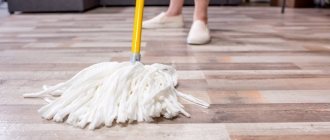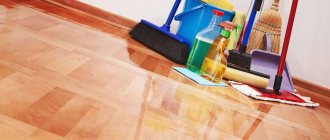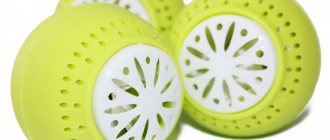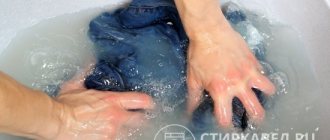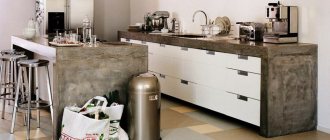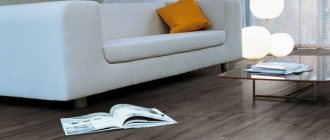What is good about linoleum? “By the fact that I laid it down and forgot!” – many fans of budget renovation will answer. But 2-3 months pass - and what do we see? The new coating no longer looks so fresh; it has lost its shine and may even have stains. For those who are not happy with this state of affairs, we will tell you how to wash linoleum so that it shines and looks the same as on the first day after repair. The main thing is to choose the right cleaning products and tactics.
How to care for linoleum?
Many housewives think that linoleum “cannot be spoiled by anything.” This is wrong. Improper cleaning leads to the fact that the appearance of the product deteriorates within 6–12 months after purchase. Therefore, it is important for everyone who values the results of repairs to know how to properly care for their flooring.
Linoleum is a relatively soft material, so it is easily deformed. It is not recommended to place furniture with narrow legs in a room with such a coating, otherwise dents and tears may appear on it. Do not move heavy objects unless they have wheels.
The top layer of material is susceptible to scratches. If crumbs and other small debris are constantly lying on the floor, the surface will quickly wear out. Therefore, linoleum in the kitchen needs to be cleaned every day:
- sweep with a broom or mop with medium-hard bristles;
- vacuum.
In other rooms, dry cleaning is carried out once every 2-3 days, depending on the rate of contamination and the number of residents.
The coating also deteriorates greatly due to small pebbles that people bring from the street on their shoes. If linoleum is laid in the hallway, then it is recommended to place a rug in front of the front door.
Over time, the paint on linoleum fades under the influence of UV radiation. We recommend closing curtains in bright sunny weather.
To shine
To maintain the shiny appearance of linoleum in the literal and figurative sense of the word, when washing floors, add potato broth, potato starch or milk to the water. After this treatment, the coating will become shiny. If you want to enhance the effect, the floor can be rubbed with special polishes, polymer mastics, drying oil or linseed oil.
To prevent loss of shine, treatment must be carried out regularly, approximately once every two months.
How to wash linoleum?
You need to wash linoleum as it gets dirty, but at least 2 times a month. Otherwise, the stains will penetrate deep into the structure of the material, and it will become impossible to get rid of them.
General rules
If you want to maintain the attractive appearance of your flooring for a long time, follow 6 basic rules:
- Before wet cleaning, be sure to sweep or vacuum the floor, otherwise you will simply smear dirt across the surface.
- Use warm water. A cold one will not help get rid of old dirt, and a hot one will wash away the protective layer and ruin the material.
- Change the water frequently to avoid spreading colonies of microbes throughout your apartment. After cleaning the bathroom or kitchen, be sure to change the water and wash the rag with soap.
- Scrub large fresh stains immediately after they appear using a kitchen sponge.
- Before using any household chemical product, test it on an inconspicuous area of the floor. There are types of coatings that do not tolerate alkalis and acids well.
- Do not mix different products. Substances in their composition can enter into a chemical reaction with each other, which will lead to unexpected consequences.
After washing, do not wait for the linoleum to dry on its own. To prevent streaks, go over the floor with a dry cloth or mop.
What should you not wash linoleum with?
The Internet is full of advice on how to use folk remedies for cleaning linoleum. Some housewives, wanting to save money, rub the floor with vinegar, soda or soap, and then regret it.
What should you not wash linoleum with and why?
- Laundry soap. Contains alkali, which destroys the protective layer of the coating. Leaves white streaks on the floor. You have to wash the linoleum twice to achieve visual cleanliness.
- Baking soda. It is not suitable for cleaning for the same reason as laundry soap - because of the alkali.
- Vinegar. The coating does not withstand acids well.
- Citric acid. Same problem as with vinegar. In addition, citric acid causes fading.
- Products with bleaching components (especially chlorine). This is a rather aggressive chemical for linoleum. Bleach spoils the color of the coating and destroys the top layer.
- Abrasive powders. Pemolux, Hostess, Comet and other similar products leave scratches on the surface.
We recommend: How to remove hard water stains from different surfaces in no time?
Among folk remedies, it is allowed to use milk and water in a 1:1 ratio or potato starch (1-2 tablespoons per 10-liter bucket). But they cannot cope with severe pollution. In addition, the floor has to be washed 2 times. Therefore, it is better to “update” linoleum at home using modern means.
Necessary equipment
The following things are suitable for washing linoleum:
- a rag from an old rag or any soft fabric;
- mop – made of microfiber, with a foam tip or plastic bristles;
- steam cleaner.
Mops with hard bristles, metal or rubber inserts cannot be used for cleaning. Such products leave scratches on the surface of a smooth floor.
If you use a rag or mop, be sure to wear rubber gloves, as household chemicals can irritate your skin. A steam generator is the most convenient way to wash linoleum, especially with a relief pattern. Only this device must be switched to mode “2” or “3” so that hot steam does not spoil the coating.
Answers on questions
When caring for linoleum, questions often arise about proper and effective cleaning of the coating. Below are answers to some of them.
How to wash linoleum with relief?
Linoleum with relief is more difficult to clean than smooth linoleum. To clean it efficiently, the floor is poured with a soap solution, left to soak, then the water is removed with a brush, acting carefully so as not to damage the surface. A special solution for cleaning linoleum will help to effectively remove dirt. For cleaning it is convenient to use a washing vacuum cleaner and special attachments.
Why do red spots appear on linoleum?
Red spots may accidentally appear because some food product (for example, beets) has been dropped on the floor, juice or fruit drink has been spilled, or the contamination may be traces of a felt-tip pen or pen. Such problems can be easily eliminated with the help of appropriate cleaning products. But there are more serious situations when linoleum turns red due to damage to the top layer of the flooring material and its partial peeling. In this case, it will not be possible to cover up or clean the stain; only partial or complete replacement of the coating will help.
The cause of dark spots appearing on the linoleum may be the glue on which the linoleum is placed. If they appear through the thickness of the coating, then it will not be possible to wipe them off from the outside. All that remains is to disguise them with carpet, furniture or replace this section of linoleum.
How to remove stain from linoleum?
You can try to wash off fresh drops of stain with alcohol, vodka, acetone or another solvent. If the affected area is large or the contamination is ingrained, it may be easier to carefully replace the stained linoleum by cutting it out.
How to remove yellow stains on linoleum?
Laundry soap will help remove yellow stains. A solution is made from it by grating and dissolving in warm water. The dirt is wiped off with a sponge or rag soaked in liquid, then wiped dry.
How to remove stains on linoleum of unknown origin?
First of all, try to remove unknown stains with a damp cloth, then use a soap solution. If this does not help, stronger means are used. You can try to get rid of unknown stains of construction origin left during repairs using a stain remover.
Linoleum has gained popularity due to the variety of colors, the ability to choose high-quality flooring material at an affordable price, and ease of maintenance. Knowing and following simple rules for everyday cleaning, removing stains and protecting the coating, you can preserve the appearance of linoleum for a long time and extend its service life.
Share link:
Modern cleaning products for linoleum
Suitable household chemicals can be divided into two groups:
- universal;
- designed specifically for washing linoleum.
It is advisable to choose concentrates and liquids from the second group to refresh linoleum. If you buy a universal product, make sure that it is suitable for cleaning floor coverings. Now let’s look at examples of good brands that have positive reviews among housewives.
HG
Dutch linoleum care product. Copes with very strong stains. Leaves a protective layer on the surface that protects the material from moisture and repels dust and small debris. With long-term use, it masks scratches and adds shine.
One bottle contains 1000 ml of product, costs about 560 rubles, and is enough for 4-8 uses. Dissolve 125-250 ml of liquid in a 10-liter bucket of warm water and wash the floor in the usual way. There is no need to wipe the product with a dry cloth. At the end of cleaning, it is recommended to lightly polish the coating.
Mellerud
German liquid for linoleum care. The price of a 1 liter bottle is 450-500 rubles. The product performs two functions simultaneously: detergent and polish. It not only cleanses old stains, but also protects against the appearance of new ones. Suitable for the first care of a new coating.
The product is applied in 4 stages:
- 60 ml of concentrate is dissolved in 10 liters of warm water and the floor is washed.
- Apply the product undiluted to a cloth napkin and treat the entire surface of the linoleum with longitudinal lines in one direction.
- Wait 30 minutes for the floor to dry.
- Apply the concentrate again to a napkin and treat the floor, but this time perpendicular to the previous layer.
You can enter the room no earlier than after 40-60 minutes. The product must dry completely - only then will the linoleum shine.
DEC
The liquid copes with stains from food, grease, and rubber shoes. Protects linoleum from scratches. A 1000 ml bottle costs 380-400 rubles.
DEC has the following features:
- does not cause allergies;
- has a subtle neutral smell of freshness;
- economical - add 2-3 caps of product to 10 liters of water, and one bottle is enough for 15-30 uses.
The method of use is the same as for HG. The liquid is dissolved in a bucket of water and then the floor is washed.
Help
Universal floor cleaner from a Russian manufacturer. They can also clean linoleum. A 5-liter bottle costs only 260 rubles, and 60 ml is enough for a 10-liter bucket of water. The product does not need to be washed off. It perfectly removes old dirt and gives the flooring shine.
"Stork"
Another budget Russian product (70 rubles per 1 liter) for cleaning floor coverings. Contains glycerin - a natural and harmless component that gives the surface of the material shine and repels dust. The manufacturer indicated on the bottle that the product has antibacterial properties.
The con does not need to be washed off. Many housewives like that after using the product, a pleasant floral aroma remains in the room.
What can't be used?
Linoleum is quite easy to maintain, but there are recommendations to extend its service life. When washing linoleum, regardless of its type, it is undesirable to use:
- baking soda : the composition contains alkali, which makes the top protective layer brittle and damages it.
- laundry soap: leaves streaks and is difficult to wash off;
- vinegar, since acids have a negative effect on the surface;
- citric acid, which causes the design to fade;
- bleaches, bleach - aggressive chemicals spoil the color, reduce brightness, and destroy the top layer. With frequent use, the coating is destroyed to the ground.
- abrasive powders that leave scratches and streaks.
How to remove old stains?
If you have not wet-cleaned linoleum for a long time, then after washing it will most likely remain stained. What is the right thing to do? It is necessary to treat old contaminants in advance using a spot method. Apply the product to the stain, leave for 5-10 minutes, then rub the surface with the rough side of the sponge and wipe with a dry cloth. Finally, wash the floor. Each type of pollution has its own method.
We recommend: What equipment will make cleaning easier and faster?
Table 1. How to remove stains on linoleum?
| Type of pollution | Suitable spot treatment |
| Fat | Dishwashing liquid, liquid soap |
| Traces from felt-tip pens and markers, iodine and brilliant green, food coloring, shoe polish | Rubbing alcohol or vodka |
| Limescale (after room renovation) | Liquid tile cleaner |
| Leftover food | Any concentrate for linoleum care |
Some online sources recommend using gasoline or kerosene to remove stains. But be careful - some types of linoleum deteriorate when exposed to oily liquids. You should also be careful with various solvents: P-646, acetone and even nail polish remover.
What tools are useful for cleaning
First of all, it should be noted that the first wet cleaning of linoleum should be done no earlier than a month after installation. During this time, dirt should be removed using a vacuum cleaner or a regular broom. As an option, you can use special wet wipes that have an antibacterial effect. Linoleum must adapt to environmental conditions.
During this period, it collects moisture from the air. If additional moisture gets on it, and this cannot be avoided during wet cleaning, the floor covering may become deformed. It is not possible to correct the situation. Therefore, practically new flooring will have to be replaced.
When cleaning linoleum, do not use abrasives. High temperatures, which have a detrimental effect on the floor covering, should also be avoided. Wet cleaning should be done with a well-wrung out cloth. It is advisable to wipe the linoleum with a previously prepared piece of flannel after wet cleaning.
If cleaning is done daily, then, by and large, the actions described above should be enough to ensure that the finish coating is not only clean, but also shiny.
Separately, I would like to say about the stains that appear on linoleum over time. To get rid of them you need to use special means. Clean linoleum from greasy stains using a regular dishwashing detergent. Using gasoline you can remove a number of stains. Namely:
- food coloring or coffee stains;
- shoe polish;
- brilliant greens;
- marker;
- Yoda.
This product will also help get rid of traces left after moving furniture. Kerosene has a similar effect. If you need to get rid of a small stain, you can use an ammonia solution. You can also try applying nail polish remover to the stain.
Linoleum needs to be washed with a soft mop.
It is more convenient to clean linoleum using special tools. To work you should prepare:
- a mop with rubber inserts;
- a floor rag;
- broom or soft brush;
- vacuum cleaner;
- pumice or fine-grained sandpaper.
Special detergents for cleaning linoleum and compositions for creating a protective layer are also useful: mastic, drying oil, polish, etc. The use of strong chemicals is not recommended, but in rare cases it is allowed.
How to restore shine to linoleum?
Almost all linoleum cleaning products have one drawback - the shine effect does not last long. After 2-3 days, the floor covering, although it looks clean, becomes dull.
Types of polishes
What needs to be done to make the floor shine for a week or even longer? To do this, after wet cleaning, linoleum is treated with protective agents - polishes. They come in two types:
- metallized;
- non-metallized.
The former contain zinc ions, thanks to which they give the flooring a crystal shine. They are highly resistant to dirt. But metallized polishes have two disadvantages: high price and deterioration in performance in wet areas (for example, in the kitchen). Non-metallic polishes are cheaper, but wear out faster.
If your goal is to disguise isolated small scratches, you don’t have to buy an expensive polish. Rub the surface with a wax candle.
How to use polishes?
To restore the shine to old linoleum, you need to follow these steps.
- Carefully treat the floor using a special detergent for linoleum to remove old stains.
- Wash the coating with clean water without adding chemicals and wipe with a dry cloth. Make sure there are no streaks left on the floor. If you ignore this step, the polish will subsequently become cloudy and flake off.
- Apply polish to a microfiber mop. Treat the floor in straight lines parallel to the rays of light. Wait for the product to dry (usually 30-40 minutes).
- Apply a second layer of polish on the first in perpendicular layers. Wait 30-40 minutes again.
In the future, you can treat the linoleum with several more layers (but no more than 6) so that it becomes glossy. It is recommended to exclude any load on the coating within 8-10 hours. Try not to go into the room.
How to check if the polish is dry? Touch the linoleum with the back of your hand. If the skin sticks a little to the surface, then you need to wait a little longer.
Complex contaminants
Doubts about how to wash linoleum can also arise when any complex stains or deep stains appear on the floor surface, requiring a special approach and the use of a set of measures.
If the stain remains on the surface for at least an hour, the traceability of its removal will be a big question.
If the stain remains on the surface for at least an hour, the traceability of its removal will be a big question
So, what is the best way to wash linoleum if its surface is dirty:
- asphalt or oil;
- wax;
- shoe polish;
- machine oil;
- coffee, iodine;
- felt-tip pen or pencil drawings.
There can be only one answer here - gasoline, kerosene. Naturally, since these products are distinguished by a certain degree of aggressiveness, it is impossible to pour it thickly onto the stain and hold it for a long time to dissolve. Here we are talking about a small amount, which is used to moisten a small cloth or cotton wool. The stain is lightly wiped with gasoline until it is completely removed, and then any available detergent for linoleum, dissolved in warm water, is used.
If there are wax, shoe polish, or asphalt stains on the surface, they must first and very carefully be removed with a spatula without causing mechanical damage to the linoleum
Many stains from linoleum can be removed with gasoline.
Let's talk separately about ink, for which gasoline will not be enough to remove. You will have to arm yourself with sandpaper or pumice.
If the question arises about what is the best way to wash linoleum floors when mold, rust, or a stain of any other plant origin is found on them, the solution to their situation will be a special solution consisting of warm water (10 parts) and bleach (1 part). If this is not enough, you should use lemon juice or a slice of any other citrus fruit.
The easiest stain in the fight for shine and cleanliness is grease, which can be easily removed with a simple soap solution. Of course, if such a stain does not belong to the old category. Then you can’t do without turpentine! Light deposits of any origin can also be quickly removed with any product you use to clean the bathtub or ceramic tiles. When thinking about how to wash linoleum in the kitchen, do not forget about the main thing: regardless of the product used, you should definitely rinse the floor with clean water after it (more than once, if necessary) and wipe it dry. Only then will you be able to achieve its original purity and shine.
Good polishes
While someone rubs linoleum with sunflower oil, risking ruining the coating, you can buy a reliable shine product at the store. We invite you to familiarize yourself with examples of good brands.
- Premiere Platinum Satin
This polish is often used by cleaning company specialists, but individuals can also order it via the Internet. Gives linoleum an unobtrusive matte shine and improves the performance characteristics of the material, in particular increases slip resistance. Apply in 1-2 layers. A 5-liter canister costs 2,800 rubles.
- Schutz Floor
German polish is suitable for the initial treatment of new linoleum and allows you to restore the surface of the old one. Facilitates further maintenance of the floor covering. After treatment, you will sweep and wash the floor less often. Dr. is available for sale. Schutz Floor is available in two types: matte and glossy. A 750 ml bottle costs 1,900 rubles.
- Viking ASL-4000
This antistatic polish is quite expensive - 11,000 rubles for a 3.8-liter bottle, but provides wear resistance for 3-6 months. The flooring shines like new. The polish dries completely within an hour after application.
Replacing a site
If the stain cannot be removed using the above methods, then a complete replacement of the affected area is practiced. It is necessary to cut out the damaged area and replace it with a new one.
When replacing, it is necessary to take into account the pattern of linoleum. This will make the replaced area invisible against the background of the rest of the coating. The entire replacement process consists of the following steps:
- A new piece of linoleum is placed on top of the old one to match the pattern.
- Both areas are cut out with a knife, and the defective flap is removed.
- Clean the resulting recess from glue and dry it.
- Apply new glue and place a new piece of linoleum there.
- If necessary, you can seal the seam using cold welding.
This will restore damaged linoleum from burn stains, tears, solvent and other damage. However, for ordinary stains such a measure is unnecessary, because they are often eliminated using the above methods.
To clean linoleum, you can use universal cleaners to remove stubborn dirt. This view compares the effects of two popular cleaners, as well as the procedure for cleaning the coating with them. It is recommended to periodically carry out such cleaning to preserve the color of the linoleum and its pattern.
Linoleum is a universal floor covering. Considering that today the assortment in the store is huge, many began to lay it at home. This popularity is explained by its ease of care; any dirt brought by children or animals can be washed off. Not every housewife knows how to wash linoleum, especially if there were carpets or laminate flooring in the house before.
